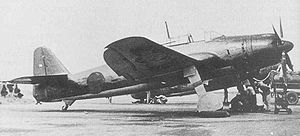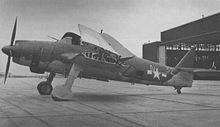Aichi B7A Video - Picture

|
|
Aichi B7A
B7A Ryusei

Role: Torpedo bomber and Dive bomber
Manufacturer: Aichi Kokuki KK
First flight: May 1942
Status: Retired
Primary user: Imperial Japanese Navy Air Service
Produced: 1941-1945
Number built: 114 total
9 - B7A1
105 - B7A2
The Aichi B7A Ryusei (æç¥ æµæè¦ä¸æ»ææ©, Aichi ryuusei-kanjou-kougeki-ki) ("Shooting Star", Allied reporting name "Grace") was a large and powerful torpedo-dive bomber produced by Aichi Kokuki KK for the Imperial Japanese Navy Air Service.
Design and development
The B7A, which was designated by Aichi as their AM-23 design, was designed in response to a 1941 16-Shi requirement issued by the Imperial Japanese Navy Air Service for a carrier attack bomber that would replace both the Nakajima B6N Tenzan torpedo plane and the Yokosuka D4Y Suisei dive bomber in IJN service. Given the codename "Grace" by the Allies, it first flew as a prototype in May 1942, but problems with the delivery of the engines meant that it was not produced in numbers until 1944, when it was too late to affect the outcome of the war. There were no aircraft carriers left for it to fly from, and only 105 aircraft were produced.
The powerplant was a 1,360 kW (1,825 hp) Nakajima NK9C Homare 12 18-cylinder two-row radial engine, and the aircraft featured a "bent" wing - an inverted gull wing somewhat reminiscent of the F4U Corsair - to give clearance from the ground for the propeller without requiring the use of long undercarriage legs.
The B7A had a weight-carrying capacity stemming from its requirements, resulting in a weapons load no greater than its predecessors. The presence of an internal bomb bay with two high-load-capability attachment points allowed the aircraft to carry two 250 kg (550 lb) or six 60 kg (132 lb) bombs. Despite its weight and size, it displayed fighter-like handling and performance, besting the version of the A6M Zero in service at the time. It was fast and highly maneuverable.
Variants
B7A1 Prototypes. Nine built. B7A2 Two-seat torpedo-dive bomber aircraft for the Imperial Japanese Navy. B7A2 Experimental One aircraft fitted with a 1,491 kW (2,000 hp) Nakajima Homare 23 radial engine. B7A3 Proposed version with a 1641 kW (2,200 hp) Mitsubishi MK9A (Ha-43). Not built.
Specifications

Picture - Aichi B7A Ryusei.
Data from Aircraft of World War II - 300 of the World's Greatest aircraft 1939-45; Aichi B7A Ryusei (Shooting Star); Japanese Aircraft of the Pacific War
General characteristics
Crew: 2
Length: 11.49 m (37 ft 8.33 in)
Wingspan: 14.40 m (47 ft 3 in)
Height: 4.07 m (13 ft 4.5 in)
Wing area: 35.40 m² (381.041 ft²)
Empty weight: 3,810 kg (8,400 lb)
Loaded weight: 5,625 kg (12,401 lb)
Max takeoff weight: 6,500 kg (14,330 lb)
Powerplant: 1x Nakajima NK9C Homare 12 18-cylinder air-cooled radial engine, 1,360 kW (1,825 hp)

Picture - Aichi B7A carrying a torpedo.
Performance
Maximum speed: 567 km/h (306 kn, 352 mph)
Range: 3,038 km (1,888 mi)
Service ceiling: 11,250 m (36,910 ft)
Rate of climb: 9.6 m/s (1,889.8 ft/min)
Wing loading: 158.9 kg/m² (32.5 lb/ft²)
Power/mass: 0.24 W/kg (0.147 hp/lb)

Picture - Captured Aichi B7A "Grace".
Armament
Guns:
2x 20 mm Type 99 Model 2 cannons in wings
1x 7.92 mm (0.312 in) Type 1 or 13 mm (0.51 in) Type 2 machine gun in the rear cockpit
Bombs:
800 kg (1,764 lb) of general ordnance or
1x 800 kg (1,764 lb) torpedo
Comparable aircraft
Douglas A-1 Skyraider
Fairey Spearfish
Bibliography
Chant, Chris. Aircraft of World War II - 300 of the World's Greatest aircraft 1939-45. Amber Books Ltd., 1999. ISBN 0-7607-1261-1.
Francillon, Ph.D., René J. Japanese Aircraft of the Pacific War. London: Putnam & Company Ltd., 1979. ISBN 0-370-30251-6.
Aichi B7A Pictures and Aichi B7A for Sale.
Living Warbirds: The best warbirds DVD series.
Source: WikiPedia